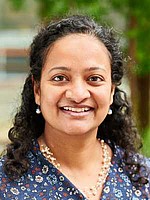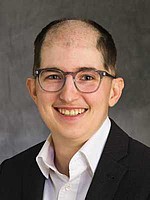Vitrimers, Sustainable Materials, and Recycling
Session Chairs
Kay Saalwächter (Martin-Luther-Universität Halle-Wittenberg, Halle, Germany)
Markus Stommel (Leibniz-Institute of Polymer Research, Dresden, Germany)
Invited Speakers

Ranjita Bose (University of Groningen, The Netherlands)
Designing Sustainable Polymer Networks through Dynamic Covalent Bonding (Shared talk with Dynamics, Dynamic Networks & Self-Healing)
Recent studies have advanced the design of crosslinked polymer networks by leveraging dynamic covalent chemistries, particularly Diels-Alder thermoreversible bonding. We explore this chemistry to obtain self-healing and reprocessable polymer networks for various applications such as 3D printing, soft robotics, shape-memory elastomers, and debondable adhesives. This lecture will cover synthesis strategies, kinetics of reversibility and structure-property relationships for enabling sustainable and circular polymers.

Joost Brancart (Vrije Universiteit Brussel, Belgium)
Diels-Alder-based polymer network design: structure, reactivity, processing and properties relations (shared talk with Dynamics, Dynamic Networks & Self-Healing)
Dynamic polymer networks can be designed very versatile through in-depth knowledge of the dynamic character of the dynamic covalent chemistries and design of the polymer network structure. Intelligent choices of dynamic covalent chemistries and their incorporation in well-designed polymer networks enable tuning of the rheological, mechanical and dynamic behaviour in view of various manufacturing methods and end-use applications.

Celine Calvino (University of Freiburg, Germany)
Quinolinone-Gated Chemistry: A Versatile Platform for Recyclable and Stimuli-Responsive Polymers (shared talk with Sensors, Actuators & Responsive Materials)
Stimuli-responsive materials offer a promising pathway toward sustainable polymer systems through controlled property changes triggered by external inputs. Here, we introduce two complementary strategies for circularity: a quinolinone-based photoreversible bonding system enabling efficient, catalyst-free polymerization and depolymerization, and its integration into dynamic networks for light-induced crosslinking and thermal reprocessing. These approaches achieve high monomer recovery and reversible material transformation under mild conditions.

Julia Kalow (Northwestern U., USA)
Upcycling with dynamic bonds (Shared talk with Network Defects & Defect Engineering)
The Kalow Lab seeks to bridge the molecular-level understanding of exchange chemistries and the macroscopic observation of flow and healing by combining physical organic studies and mechanical characterization. We have developed a tunable catalyst-free associative exchange reaction based on conjugate addition–elimination of thiols. In this talk, I will discuss strategies to upcycle polymer waste through incorporation of these dynamic bonds.

Andreas Klingler (IVW Kaiserslautern, Germany)
Transition phenomena in vitrimers
Vitrimers, a class of dynamic polymer networks, can reversibly transform from a cross-linked thermoset phase into a flowable state. Although this transition evidently takes place, the nature of the transformation process remains poorly understood. In this talk, the vitrimer transition phenomenon shall be discussed from the perspective of dynamic thermal volume expansion and will be put into context within the framework of other transition phenomena.

Alexa S. Kuenstler (Univ. Illinois, USA)
Resolving the Effects of Chemistry and Polymer Network Structure on the Viscoelasticity of Dynamic Covalent Networks (shared talk with Network Defects & Defect Engineering)
The viscoelasticity of dynamic covalent networks arises from the interplay between bond exchange kinetics and polymer chain dynamics. In this talk, we will consider how these features can be independently tuned through synthetic approaches, and discuss how rheological measurements combined with coarse-grain models can reveal the distinct contributions of each to emergent behavior.

Ralm Ricarte (FAMU-FSU Tallahassee, USA)
Polydimethylsiloxane/Polybutadiene Vitrimer Blends
Vitrimers are polymer networks cross‑linked by dynamic covalent bonds that undergo associative exchange, wherein new bonds form before existing ones break. This talk focuses on how converting an immiscible mixture of polydimethylsiloxane and polybutadiene into a vitrimer affects the blend properties. We find that associative cross-links complicate phase behavior but simplify linear viscoelasticity, i.e., the slow relaxation dynamics are decoupled from the blend morphology

Sandra Schlögl (Polymer Competence Center Leoben, Austria)
With light towards functional dynamic polymer networks (shared talk with Dynamics, Dynamic Networks & Self-Healing)
Combining the chemistry of dynamic covalent bonds with light-driven reactions offers versatile routes to advance the functionality of dynamic polymer networks. Herein, examples of photochemical reactions are provided, which are used to shape functional dynamic polymers along various length scales, to locally and reversibly control bond exchange kinetics and to reprogram material properties during post-processing steps.

Dimitris Vlassopoulos (FORTH Heraklion, Greece)
Rheological properties of model vitrimers
Vitrimers are known to combine the desirable properties of both thermoset and thermoplastic materials. The key feature is the presence of associative dynamic covalent bonds. We present a systematic rheological investigation of two types of well-studies (that are needed to identify microphase separation and clustering where appropriate). One involves low-Tg telechelic primary segment that forms the network, the other involves high-Tg segment with randomly distributed bonds. We explore the thermal annealing and address the challenge of topological transition temperature Tv and its unambiguous determination. There is an interesting analogy for the former class of vitrimers to triblock copolymers and the latter to random copolymers. We also address the nonlinear rheology of these interesting materials, as it is relevant to their possible processing and blending with homopolymers. The latter is important for possible recycling applications and we discuss some first results in this direction.
Contributed talks and posters
... will be continuously added until the abstract acceptance deadline.